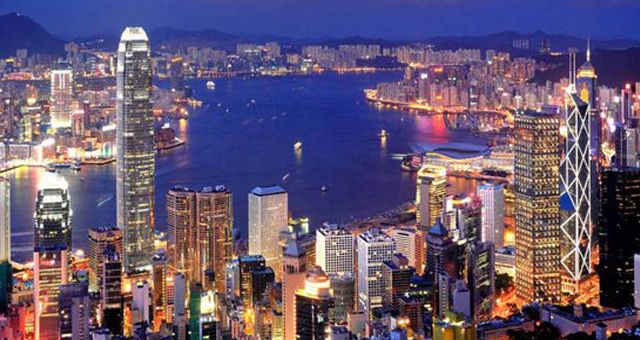
Shanghai highlights its plans for free trade port and science center
The free trade port, based on the city’s pilot free trade zone, has entered the planning stage and will be implemented after approval from central government, Han told a press conference on the sidelines of the Party’s 19th National Congress in Beijing.The government approved a plan to comprehensively expand the opening-up of the China (Shanghai) Pilot Free Trade Zone in May. Han said that marked the “3.0 version” of the FTZ following its establishment in 2013 and the first growth in its opening-up in 2015.“Through years of reform, there have been over 100 innovative institutions promoted nationwide,” Han said.The Ministry of Commerce has announced the launch of another seven free trade zones, taking the nation’s total to 11.As China’s first FTZ, the Shanghai zone has gained experience that will inform the development of the other zones.Another major task for Shanghai is to accelerate the development of a scientific innovation center with “global influence,” Shanghai Mayor Ying Yong told reporters.“The city government has decided to form a central basic framework of the scientific innovation center by 2020 and form its core function by 2030,” Ying said.As a core part of the plan, the city will establish a Zhangjiang Comprehensive National Scientific Center in the Pudong New Area, which will involve a batch of world cutting-edge major scientific facilities as well as world-leading research institutes and innovation groups, Ying said.To achieve that goal, Shanghai has planned a Zhangjiang Science City covering 94 square kilometers, which aims to be on a par with California’s Silicon Valley, Singapore’s One North science park and Japan’s Tsukuba scientific town, according to the Shanghai Planning, Land and Resources Administration.Ying said the city government has issued a set of guidelines to support foreign research and development centers based in Shanghai to play their part in the city’s scientific innovation center ambitions.More policies will be issued to create a “highland for professionals” as well as serve the scientific innovation center, Ying added.“Shanghai is in more urgent need than in any other period of talent,” he said.At present, more than 610 global or regional headquarters of multinational companies have been set up in Shanghai along with over 418 research and development centers, according to the government.Reporters were also told by Han that the city banned close family members of senior government officials from running businesses in a pilot regulation launched in May 2015 ahead of a nationwide rollout. Regular investigations will be launched to check at least 20 percent of local officials, Han said.He also promised to further improve air quality in the city by reducing the density of hazardous PM2.5 fine particles to 40 micrograms per cubic meter this year from 45mg last year.Han said the security of city residents was of top concern.“We have put how to eliminate safety risks as our daily focus to ensure the life and property safety of the people,” he said.
China’s retail business shows sign of structural recovery
China’s retail business has shown a sign of structural recovery as its large retailers began to pick up growth since the second half of 2016.Sales of 2,300 retailing enterprises in China grew by 4.1% year on year in the first 6 months of 2017, according to statistics from the country’s Ministry of Commerce.Data showed that China had 18.12 million retailers by the end of 2016, up 5.2% year on year, the ministry said in a report issued in July, adding that total retail sales of consumer goods in 2016 hit 29.7 trillion yuan ($4.5 trillion), up 10.4 percent on a yearly basis.Besides, the retail sector has seen decreased debt ratio and increased profits, with sales rising especially in convenient stores, shopping malls, and supermarkets.Large Chinese retailing enterprises experienced sluggish growth since 2011, and even negative growth in recent two years, resulting in large-scale shutdowns of physical stores, especially megastores and hypermarkets in many regions.Despite of the recession faced by the physical retail, e-commerce has been developing rapidly in China. In 2016, the country’s e-commerce transactions accounted for 35% of its GDP.“The growth of e-commerce is not the major reason for closing of physical stores,” said Vice Minister of Commerce Wang Bingnan.He pledged previously that China will boost the entity economy by encouraging the application of Internet and other new technologies in physical stores and curtailing unreasonable fees to reduce enterprises’ burdens.In order to curb the recession of physical stores, the Chinese government is also encouraging the retail business to seek for integrated development and nurture a new type of market entity that merges both online and offline services.
Cargo train services connect China with 34 European cities
A working meeting on deepened international cooperation of China-Europe freight trains was recently held in Zhengzhou, central China’s Henan Province. The event came as data showed that the trains have connected China with 34 cities in 12 European countries after six years of operation. During the three-day meeting starting on Tuesday, more than 70 railway representatives from China, Belarus, Germany, Kazakhstan, Mongolia, Poland and Russia discussed their collaboration roadmap as well as working plans for the joint working group they set up. It was also their first meeting as members of the group. The conference marked an intensified cooperation on China-Europe cargo train services. China-Europe freight train, or China Railway Express to Europe, is a cargo train service between China and Europe, as well as Belt and Road countries that runs on fixed routes and schedules. More than 5,000 cargo train trips have been made between China and Europe since the start of the direct rail freight services six years ago, half of which were made in 2017, showed statistics from China Railway Corporation (CRC). A total of 57 routes have been opened, linking 34 Chinese cities with 34 European cities in 12 countries. In 2016, the number of China-Europe freight trains surpassed 1,700, including 1,130 outbound trains and 572 inbound trains, an increase of 109 percent year on year. The 13,052-kilometer rail from eastern China’s city of Yiwu to Madrid via Alataw Pass in Xinjiang Uyghur Autonomous Region has been in operation for more than 1,000 days since it set off for the first time on November 18, 2014. Currently, nine routes from Yiwu to Europe have been opened, including the ones to Madrid, London and Prague. With 5 logistics centers and eight overseas warehouses, these routes radiate 34 countries. The freight train service transports goods from eight Chinese provinces and municipalities including Zhejiang, Guangdong, Anhui, Jiangsu and Shanghai, covering nearly 2,000 items of China-made products such as small commodities, clothes, bags and tools. Overseas projects, including the China-Belarus Industrial Park, and a wholesale market for small commodities set up by China in Warsaw, also benefited from the service. Railway authorities of China, Belarus, Germany, Kazakhstan, Mongolia, Poland and Russia, inked an agreement to deepen cooperation on China-Europe freight rail services this April, said CRC, adding that this meeting held at its call aims to ensure a better implementation of the agreement. During the three-day meeting, representatives also discussed next year’s plans, specific operation of the broad-gauge sections, time and place for the team's next meeting and procedures for new member enrollment.
Hunan to Promote Investment
The Hunan Provincial Government recently published a Notice on Promoting and Attracting Investment which presented its new guidelines for investing, implementing national policies, and carrying out its strategy of ‘innovation-driven development’ and promoting Hunan via ‘opening up’.There are 22 sections concerning four areas: new investment promotion measures; investment related policies; improving the investment environment; and strengthening organization and services.Hunan government will encourage enterprises to invest in Hunan public service PPP (public-private-partnership) projects; encourage various levels of government to coordinate funds in support of major investment projects; and, encourage local governments to award or subsidize administrative and institutional urban construction fees for important industrial and innovation investment projects.Priority will be given to guaranteeing essential production factors, such as water, electricity, and gas for key industrial projects; introducing more industrial parks to be included in the national pilot incremental distribution network; encouraging businesses in industrial parks to be involved in direct electricity transaction; and, providing proper logistics subsidies for important projects according to local situations.It prioritizes providing land for the projects involved in the national Catalogue for the Guidance of Industries for Foreign Investment; the Catalogue for the Guidance of Advantage Industries for Foreign Investment (Hunan section); and, the Hunan Catalogue for the Guidance of Key Industries for Investment Promotion.Foreign-funded enterprises are encouraged to be listed on the main board, small and medium-size enterprise board, growth enterprise board (GEB), and international board, according to laws and regulations. The listed enterprises will enjoy the similar preferential policies as domestic ones.
The strategic cooperation between Hebei Luquan Economic Development Zone and Tanikawa
Recently, Tanikawa signed a cooperation agreement with the Hebei Luquan Economic Development Zone, the two sides will focus on project excavation, investment information and other aspects to develop deep cooperation. It has great significance that enhance inviting investment strength and promote regional industrial transformation and upgrading for the Luquan Economic Development Zone.Hebei Luquan Economic Development Zone is committed to create a new city with functional, rational layout, distinctive characteristics, beautiful environment, the total economic and comprehensive development level ranks the forefront in Hebei provincial-level development zones. At the same time, relying on innovation-driven and technology support, the development zone formed five small and medium-sized science and technology industry cluster, to build a good platform for relevant enterprises investing in the development zone. Luquan Economic Development Zone has been formed it's industrial system in terms of electronic information, green food, intelligent manufacturing and modern service. Now, there are 363 enterprises started their business operation in the development zone, the existing 363 enterprises into the zone, of which 92 enterprises' turnover is more that ¥2,000 million.
Guangdong FTZ Regulation encourages innovation
The Guangdong FTZ Regulation will come into effect since July 1. "The most important thing in the Regulation is to encourage innovation by law protection," said by Liu Yuelun, vice chairman of the Standing Committee of Guangdong Provincial People's Congress on a conference on promoting the Regulation. In short, citizens, legal persons and other organizations are encouraged to make innovations in Guangdong FTZ only if their projects haven't been prohibited by law. According to Liu, "Guangdong FTZ initiates the fault tolerance mechanism for innovation." For instance, if a customs clearance agency launched a measure to collect shipping companies' file with big data and aims to provide 5,000 companies' information for customs departments each year. However, that company couldn't finish that goal, it won't be blamed or punished since that innovation does bring some revolutionary progress. The Regulation also gives priority for cooperation among Guangdong, Hong Kong, Macao and the countries along “Belt and Road”. On the one hand, service trade facilitation between Guangdong and Hong Kong, Macao will be promoted. On the other hand, Guangdong FTZ will further its opening up and seek cooperation with FTZs, countries along the Belt and Road in finance, shipping, tourism and other fields. Other highlights in the Regulation include administrative system, investment and trade facilitation and opening, promotion of high-end industries, financial innovation, etc.

Please leave us a message and we will get back to you shortly.

If you want to learn more information about investing in China, please leave your email address, we will send you the relevant information and article every month.
 0086-10-53270173
0086-10-53270173 china@tanikawa.com
china@tanikawa.com











